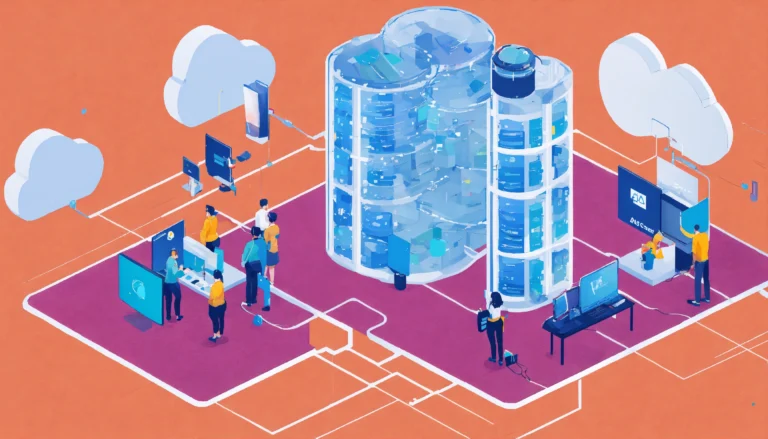You may not realize it, but M2M technology is transforming how you manage your supply chain. By enabling devices to communicate directly with one another, this technology enhances the efficiency of operations, reduces costs, and minimizes errors. With real-time data and predictive analytics, you can optimize logistics, improve inventory management, and respond swiftly to disruptions. Embracing M2M solutions can lead to significant improvements in your supply chain, ensuring that you stay ahead of the competition while delivering better service to your customers.
Understanding M2M Technology
Definition and Components
The term M2M, or Machine-to-Machine technology, encompasses a diverse array of systems that enable devices to communicate and exchange data without human intervention. This technology relies on a combination of hardware and software components that facilitate seamless connectivity between machines, allowing for real-time data transfer, analysis, and action. With M2M technology, you can expect a streamlined process in various applications from healthcare to logistics. (This could lead to significant improvements in operational efficiency and decision-making.)
For a comprehensive understanding of M2M technology, it’s important to recognize its core components, which typically include sensors, communication networks, data processing systems, and user interfaces. Sensors collect data from environments and machines, while communication networks transmit this data to processing systems. These systems analyze the data to provide actionable insights, which users can access through intuitive interfaces, making your operational processes more informed and timely.
Key Features and Capabilities
By leveraging M2M technology, you gain access to an array of key features and capabilities that enhance your supply chain management. These features can include:
- Real-time data transmission: Ensures timely updates and visibility across your supply chain.
- Automated alerts: Notifications when specific thresholds are reached, enabling proactive responses.
- Remote monitoring: Allows for oversight of equipment and conditions from any location.
- Data analytics: Turns raw data into actionable insights that inform your decision-making.
- Scalability: Easily adapts to changes in your operations, accommodating growth or contraction.
The integration of these features means that your supply chain processes become more efficient, responsive, and reliable.
Understanding these key features allows you to utilize M2M technology effectively for bolstering operational efficiencies in your supply chain functions. Each feature serves a distinct purpose, such as:
- Enhanced connectivity: Linking various elements of your supply chain for improved communication.
- Predictive maintenance: Anticipating equipment failures before they occur to avoid delays.
- Supply chain transparency: Providing real-time visibility into inventory levels and logistics.
- Cost reduction: Minimizing operational costs through automation and better resource management.
The capabilities that M2M technology fosters pave the way for significant advancements within your supply chain management strategy.
M2M Technology in Supply Chain Management
Real-Time Monitoring and Data Collection
At the forefront of M2M technology in supply chain management is the ability for you to engage in real-time monitoring and data collection. This means that you can track shipments, inventory levels, and equipment status instantaneously, providing a level of oversight that was previously unattainable. With sensors and connected devices collecting data on location, temperature, and humidity, you can ensure that products are maintained in optimal conditions throughout their journey. This timely information empowers you to make informed decisions and minimizes the risks of spoilage or damage during transportation.
At the same time, real-time data collection can streamline your operations by identifying potential problems before they escalate into bigger issues. For example, if a shipment is delayed, you can respond quickly to reroute delivery or adjust your inventory management strategy, ultimately reducing downtime and enhancing customer satisfaction. The shift towards a data-driven approach allows you to gain deeper insights into your supply chain, promoting greater efficiency and effectiveness.
Automation of Processes
The automation of processes is another powerful feature of M2M technology that enhances your supply chain management. By implementing automated systems for inventory tracking, order processing, and even predictive analytics, you can significantly reduce the amount of manual work involved. This not only saves you time and resources but also minimizes human error, leading to a more efficient and reliable supply chain. Investing in automation tools allows your organization to focus on strategic initiatives rather than getting bogged down in repetitive tasks (the transition to automation will inevitably reshape your workforce).
To fully leverage the benefits of automation, it’s vital to integrate M2M devices seamlessly with your existing systems. Doing so allows for a smooth flow of information between technology platforms, ensuring that you have cohesive control over your operations. This holistic view is instrumental in enhancing your productivity and responsiveness in a fast-paced market environment. So, you may decide to prioritize automation as a core aspect of your supply chain strategy to maximize both efficiency and customer satisfaction (the choice to automate could lead to significant cost savings over time).
Enhancing Efficiency with M2M
Any organization aiming to improve its supply chain management can greatly benefit from Machine-to-Machine (M2M) technology. By automating processes and facilitating real-time communication between devices, M2M helps you enhance operational efficiency. Through various applications like remote monitoring and automated data collection, you can reduce human error and streamline workflows, leading to a faster and more responsive supply chain. Furthermore, M2M technology elevates your inventory management practices by providing timely updates and insights, ensuring that you have the right products available at the right time.
Inventory Management Solutions
Among the significant advancements in inventory management, M2M technology plays a transformative role. By leveraging connected devices, you gain visibility into your inventory levels, allowing for real-time tracking and automated reordering processes. This level of precision helps you minimize stockouts and overstock situations, which often lead to lost sales or unnecessary holding costs. With M2M systems, you can also integrate data from various supply chain partners, offering a holistic view of your inventory across multiple locations.
Predictive Analytics for Demand Forecasting
Management of your supply chain hinges on accurately predicting customer demand, and M2M technology amplifies your ability to execute this task effectively. By utilizing advanced predictive analytics, you can analyze vast amounts of data gathered through M2M devices, including sales trends, seasonal fluctuations, and consumer behavior patterns. These insights allow you to make informed decisions regarding inventory levels, production schedules, and distribution practices, ultimately leading to improved customer satisfaction.
Enhancing your demand forecasting capabilities with M2M technology not only drives operational efficiency but also contributes to a sustainable competitive advantage. As you embrace predictive analytics, you can proactively adjust your supply chain strategies, reducing waste and aligning production with actual demand. This means less capital tied up in excess inventory and more efficient resource allocation, translating into heightened profitability and customer loyalty. With these tools at your disposal, you’re equipped to maneuver through market fluctuations and optimize your supply chain operations effectively.
Reducing Costs through M2M Implementation
Despite the evolving complexity of modern supply chains, M2M technology provides powerful solutions for cost reduction. By integrating connected devices throughout your operations, you can achieve significant operational cost savings that go beyond traditional methods. This technology enables you to monitor equipment, track inventory levels in real-time, and streamline your logistics processes. Implementing M2M solutions allows you to automate routine tasks, reducing the volume of manual errors and enhancing overall efficiency. (Investing in M2M implementation today can lead to substantial financial benefits tomorrow.)
Operational Cost Savings
Any business aiming to thrive in today’s competitive landscape must consider the impact of operational cost savings through M2M technology. You can significantly lower costs by utilizing connected devices that provide immediate feedback on your operations, allowing you to make data-driven decisions. This proactive approach not only helps you to identify inefficiencies promptly but also empowers you to allocate resources more effectively. (Real-time data analytics derived from M2M can guide your business toward a leaner operation.)
Minimizing Waste and Loss
Cost implications extend beyond operational expenses; minimizing waste and loss is an vital aspect of optimizing your supply chain. By implementing M2M technology, you enhance your ability to monitor product conditions, helping you to avoid spoilage, theft, and excess inventory. Leveraging data gained from connected devices can inform better practices that keep your supply chain streamlined and waste to a minimum. (Enhanced monitoring capabilities enable your team to respond promptly to any discrepancies or irregularities.)
Minimizing waste and loss effectively requires a strategic approach toward monitoring and data management. With M2M technology, you gain insight into inventory accuracy, enabling you to quickly react to changes in demand or supply chain interruptions. This responsiveness can translate into improved profitability, as you’re less likely to incur costs associated with overproduction or unsold stock. Additionally, real-time tracking allows you to identify potential points of waste in your processes and provide immediate solutions, fostering a culture of continuous improvement within your organization. (Adopting M2M technology could be transformative for your bottom line while contributing to sustainability goals.)
Case Studies: Successful M2M Integration
Now, examining real-world examples can shed light on how M2M technology is shaping the landscape of supply chain management. Numerous companies have successfully integrated this technology, leading to enhanced efficiency and reduced operational costs. Here are some noteworthy cases:
- Company A achieved a 30% increase in inventory accuracy by implementing an M2M tracking system for real-time stock level updates.
- Company B reported a 25% reduction in delivery times after employing M2M devices to monitor vehicle locations and conditions.
- Company C realized a 40% decrease in supply chain disruptions through predictive maintenance powered by M2M sensors, allowing proactive equipment management.
- Company D saw a 15% drop in operational costs due to optimized routing algorithms enabled by M2M data analytics.
Industry Examples
Beside addressing specific corporate challenges, the integration of M2M technology has also demonstrated compelling outcomes across various industries. For instance, the healthcare sector utilizes M2M for remote patient monitoring, resulting in a dramatic decrease in hospital readmissions by around 20%. Similarly, the manufacturing industry has benefited significantly from real-time data on machinery, enhancing production line efficiency and optimizing resource allocation.
Additionally, in the retail space, retailers using M2M technology for inventory management have experienced a decrease in stockouts by approximately 50%. This has led to improved customer satisfaction and increased sales. As you evaluate these examples, consider how M2M technology can address your specific supply chain challenges.
Lessons Learned
Lessons from these case studies highlight the importance of adopting M2M solutions tailored to your unique environment. Organizations that proactively embraced M2M integration have usually outperformed their competitors, demonstrating that investing in technology leads to significant operational benefits (decisions made early in the process often yield the best outcomes). Moreover, collaboration with technology partners was a common theme in successful implementations, enabling firms to leverage specialized expertise effectively.
Understanding the outcomes of these implementations can provide you with insights into your strategy. Failing to account for data security measures may expose your organization to risks, while investing in training can maximize user engagement with M2M systems. Ultimately, your approach to integrating M2M technology should be strategic, focusing on developing a comprehensive plan that includes performance metrics and risk assessments (this careful planning is paramount for long-term success).
Challenges and Considerations
Unlike traditional supply chain management methods, the implementation of M2M technology comes with its own set of challenges and considerations. One of the primary concerns you must think about is data security and privacy. As devices become interconnected, the amount of sensitive information being transmitted increases significantly, making it a potential target for cyberattacks. It is necessary that you ensure proper measures, such as encryption and robust security protocols, are in place to protect your data. (Determining the right security measures can be a significant decision that influences your M2M deployment.)
Data Security and Privacy Concerns
Considerations around data security and privacy are not simply optional; they are foundational to the success of your M2M supply chain initiatives. You need to be aware of the potential vulnerabilities that exist in your network, and take proactive steps to mitigate risks. Implementing a strong governance framework can assist in addressing these issues and ensuring compliance with relevant regulations like GDPR, contributing to a more secure data environment.
Infrastructure and Adoption Barriers
For you to fully leverage the benefits of M2M technology in your supply chain, you need to navigate various infrastructure and adoption barriers. These can range from the substantial upfront costs associated with integrating new technology to the need for skilled personnel who can manage and maintain these systems. The compatibility of your existing infrastructure with newfound technology is also something you must assess to avoid potential disruptions to your operations.
With infrastructure modernization being a significant undertaking, you might face challenges in aligning your technological capabilities with the demands of innovative M2M solutions. Ensuring seamless integration may require substantial investments in both hardware and software, as well as ongoing support for your team. Additionally, fostering a culture of acceptance within your organization regarding technological change is vital; you need to address employee concerns about automation while positioning M2M as an transformative opportunity rather than a threat. By navigating these challenges effectively, you can pave the way for a more resilient and efficient supply chain.
Final Words
Hence, understanding how M2M technology is revolutionizing supply chain management empowers you to leverage its potential effectively. By integrating IoT devices and enabling communication between machines, you can enhance real-time data collection, leading to better inventory management, reduced operational costs, and improved customer satisfaction. This intuitive technology allows you to track goods throughout the entire supply chain, facilitating quicker response times and informed decision-making that ultimately drives efficiency and profitability in your operations.
By adopting M2M solutions, you position your business at the forefront of innovation in supply chain management. Embracing these advancements not only prepares you for a competitive marketplace but also fosters a connected ecosystem that aligns your resources and streamlines processes. As you navigate the evolving landscape of supply chain dynamics, harnessing the power of M2M technology will serve as a catalyst for your growth and success.




